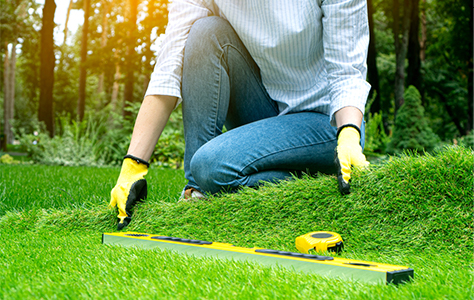Artificial turf is a surfacing material made of synthetic that mimics the look of real grass. Previously, artificial turf was used for golf putting greens and athletic fields but now is widely used in residential lawns and commercial properties as a substitute for lawn sod grass installation. Synthetic turf is made from polymer fibers like polyamides, polypropylene, or nylon and is highly preferred over natural grass due to high durability, low environmental impact, and less requirement of water. These turfs also contain anti-bacterial properties which prevent the spread of bacteria and germs and do not require any form of hazardous chemical pesticides, thus are pet and child friendly.
?Modern artificial turf is easy to maintain, does not require mowing or watering, unlike real grass. This helps to save a million gallons of water otherwise required for sports fields, golf courses, lawns, and landscaping. In addition, these turfs are not affected by bad weather conditions and are best suited for all types of weather. Rapid urbanization across the globe and improving standard of living has led to surging demand for low maintenance exterior and interior d?cors such as artificial gardens and landscapes. Artificial turfs are widely installed in modern residential and commercial complexes along with sports arenas, commercial gardens, and stadiums.

In recent years, eco-conscious consumers are shifting to artificial turfs to reduce water use, and overall carbon footprint and with the advantage of spending less time on maintaining the lawn. To keep the synthetic turf good looking all year round, it needs to be rinsed at least twice a month, and sitting debris and dirt need to be removed using a leaf blower or rake.
Various sports stadiums and clubs are replacing natural grass with artificial turfs. Many manufacturers are focused on developing mud-free, skid-free synthetic turf suitable for sports, indoor arena, terrace, and top roof gardens and playgrounds. In addition, various players are investing in developing artificial turfs approved by FIFA, FIH, or ITF.
Key Benefits of Artificial Turfs
Artificial turf offers various advantages over traditional turfs some of which are listed below.
- Durability: Though synthetic turfs require high initial investments, majority of the turfs available today have high durability and longevity. If maintained well, these turfs can last up to 25 years.
- Aesthetic Appeal: Artificial turfs help to enhance the aesthetic appeal of the space and improve curb appeal. Over the recent years, various types of synthetic turfs with a variety of colors, thicknesses, lengths and finishes are easily available in the market.
- Low Maintenance: Synthetic turfs help owners to save time as well as money as these do are require watering, mowing, or fertilizers. It also eliminates additional investments in lawn mowers and lawn care equipment.
- No Need of Harmful Pesticides or Fertilizers: Ample of water, pesticides, and fertilizers are required to maintain real grass and lawns. Artificial turf saves a lot of money on pesticides, fertilizers, and other weed killers.
- Safe Surface: Natural lawn often develops humps and uneven surfaces which can cause injuries which walking or playing. The synthetic turf is evenly smooth and avoids severe injuries after falls.
- Pets and Children Safety: These artificial turfs are an ideal choice for families with children and pets. These turfs are mud and dirt free which keeps kids cleaner than the real lawn and also prevents injuries caused by falls. These also keep pets clean from dirt and mud, prevent them from digging holes and eliminate muddy foot and paw prints even during the rainy season. The antimicrobial properties in some turfs prevent building up bacteria and odors.
Artificial Turf Market Overview
Artificial turfs are rapidly gaining popularity owing to rising demand for durable, low maintenance, and cost-effective artificial floorings, rising number of residential and commercial complexes with top roof gardens, terrace gardens, and beautiful landscapes, and increasing sports events across the globe. The global artificial turf market size is expected to reach USD 5,707.2 million in 2028 and register a revenue CAGR of 4.9% during the forecast period, 2021 to 2028.? ?
Factors such as increasing number of pet owners, increasing demand for artificial turfs in schools, sports clubs, playgrounds, indoor arenas, rapidly growing construction sector, and government support for infrastructural upgradation are expected to fuel the market growth during the forecast period. Other factors such as improving standard of living, rising disposable income, and increasing investments for developing hybrid artificial turfs are expected to fuel market growth going ahead. However, low resistance to heat, high installation costs than traditional landscaping projects, requirement of frequent infill replenishment and high chances of building up odor over time are some factors expected hamper overall market growth going ahead.

As the editor of the blog, She curate insightful content that sparks curiosity and fosters learning. With a passion for storytelling and a keen eye for detail, she strive to bring diverse perspectives and engaging narratives to readers, ensuring every piece informs, inspires, and enriches.









